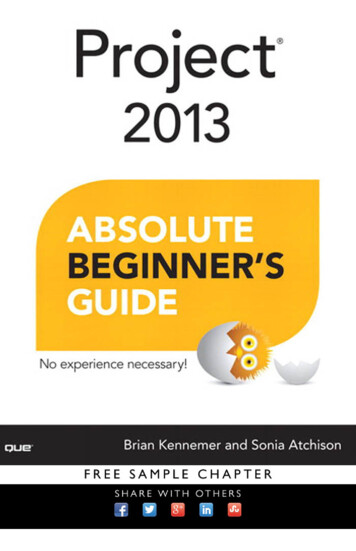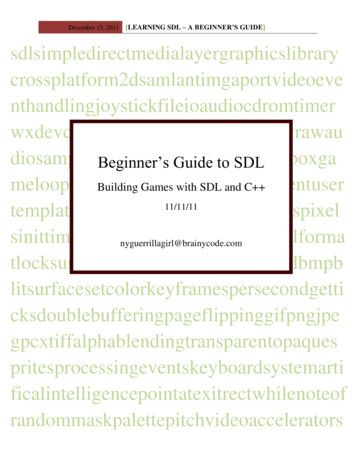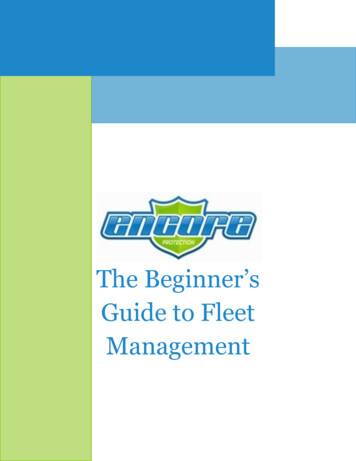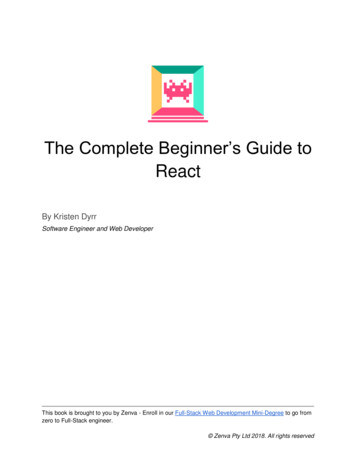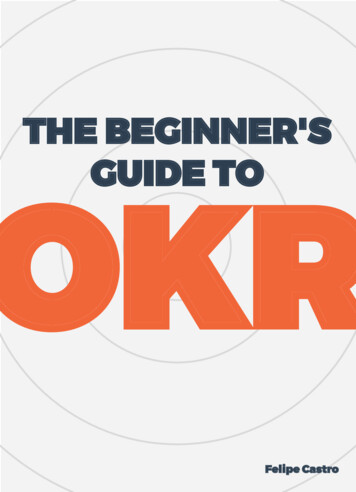
Transcription
The Beginner's Guide to OKRFelipe CastroTHE BEGINNER'SGUIDE TOOKRFelipe Castro
The Beginner's Guide to OKRFelipe CastroThe Beginner’sGuide to OKRObjectives and Key ResultsWhy I wrote this guide?There are several guides to OKR. But they lack the solid foundations that will allow you tostart at the beginning and will enable to to successfully adopt OKR.I wrote this guide for first-time OKR users, but in my experience many long-time OKRusers also find it valuable. Many of them lack the proper concepts to win with OKR.My advice is that you should read this guide cover-to-cover, as each section builds uponthe previous ones. Reading it from start to finish will help you understand how thedifferent OKR building blocks fit together and why OKR has been successfully adopted bygreat companies such as Google, Spotify, Twitter, Airbnb and LinkedIn.Felipe Castro2
The Beginner's Guide to OKRFelipe CastroTable of contentsWhat is OKR?What are the benefits of using OKR?Strategic vs. Tactical OKRs: Nested CadencesOKRs do not CascadeSuccess criteria and types of Key ResultsHow ambitious should your OKRs be?Creating AlignmentTracking Results with the Weekly Check-inA Typical OKR CycleWhy you should separate OKR and compensationCommon OKR mistakesWhat's Next?3
The Beginner's Guide to OKRFelipe CastroWhat is OKR?OKR (Objectives and Key Results) is a goal setting system used by Google and othercompanies. It is a simple approach to create alignment and engagement aroundmeasurable and ambitious goals.The big difference from traditional planning methods? OKRs are frequently set, tracked,and re-evaluated – usually quarterly. OKR is a simple, fast-cadence process that engageseach team’s perspective and creativity.OKR exists to create alignment and to set the cadence for the organization. The goal is toensure everyone is going in the same direction, with clear priorities, in a constant rhythm.OKR’s original concept came from Intel and spread to other Silicon Valley companies.Google adopted OKR in 1999, during its first year. It supported Google’s growth from 40employees to more than 60,000 today.Besides Google, other companies use OKR, including Spotify, Twitter, LinkedIn, andAirbnb.But OKR is not only for digital companies. Walmart, Target, The Guardian, Dun andBradstreet, and ING Bank are also using OKR.4
The Beginner's Guide to OKRFelipe CastroUnderstanding the OKR ComponentsJohn Doerr is one of the most successful venture capitalists of all time. He started hiscareer at Intel and went on to invest in companies such as Google and Amazon. Doerr,who introduced Google to OKR, has a formula for setting goals:Doerr’s Goal FormulaI will as measured by .A proper goal has to describe both what you will achieve and how you are going tomeasure its achievement. The key words here are “as measured by,” since measurement iswhat makes a goal a goal. Without it, you do not have a goal, all you have is a desire.Doerr’s formula is the best way to explain the structure of an OKR:I will (Objective) as measured by (this set of Key Results).So, as the name implies, OKR has two components, the Objective and the Key Results:Objectives are memorable qualitative descriptions of what you want to achieve. Objectivesshould be short, inspirational and engaging. An Objective should motivate and challenge theteamKey Results are a set of metrics that measure your progress towards the Objective. For eachObjective, you should have a set of 2 to 5 Key Results. More than that and no one will rememberthem.5
The Beginner's Guide to OKRFelipe CastroAll Key Results have to be quantitative and measurable. As Marissa Mayer, a former Google’s VicePresident, said:If it does not have a number,it is not a Key Result.Example OneFirst of all, we need an Objective. An example might be “Create an Awesome CustomerExperience.” This sounds great, but how would you know if the experience is awesome?Remember, without measurement you don’t have a goal.That is why we need Key Results. How can we measure if we are providing an awesomecustomer experience? Net Promoter Score and Repurchase Rate would be two goodoptions. Do our customers feel so good about dealing with us that they wouldrecommend us and buy again?But measuring NPS and repeat purchases alone can send the wrong message. It mightencourage us to make the customer happy at any cost. Therefore, we can include acountermeasure such as Customer Acquisition Cost. We want to make our customershappy while keeping the costs under control.6
The Beginner's Guide to OKRFelipe CastroThe complete example would be:Objective:Create an Awesome Customer ExperienceKey Results: Improve Net Promoter Score from X to Y. Increase Repurchase Rate from X to Y. Maintain Customer Acquisition cost under Y.Example TwoNow consider a team that wants to increase the engagement with a digital service:Objective:Delight our customersKey Results: Reduce revenue churn (cancellation) from X% to Y%. Increase Net Promoter Score from X to Y. Improve average weekly visits per active user from X to Y. Increase non-paid (organic) traffic to from X to Y. Improve engagement (users that complete a full profile) from X to Y.Once more having a set of Key Results helps create a healthy, sustainable OKR. We wantto increase the weekly visits, but we want it to be organic, not through an expansion ofmarketing spend.Key Results are crucial. Most of all, they define what we mean by “Delight our customers.”A second team or company could use the same Objective with different Key Results.7
The Beginner's Guide to OKRFelipe CastroWhat’s unique about OKR?There is not a single way to use OKR, each company or team can adapt and tweak it,creating different versions of it. But there are some core concepts:Agile GoalsInstead of using annual static planning, OKR takes an agile approach. By using shortergoal cycles, companies can adapt and respond to change.SimplicityUsing OKR is straightforward, and the OKRs themselves are easy to understand. Intel’soriginal model set goals monthly, which required a lightweight process.Companies that adopt OKR reduce the time spent setting goals from months to days. Asa result, they invest their resources in achieving their goals and not on setting them.TransparencyThe primary purpose of OKR is to create alignment in the organization. To do so, OKRs arepublic to all company levels — everyone has access to everyone else’s OKRs. The CEO’sOKRs usually are available on the Intranet.Nested CadencesOKR understands that strategy and tactics have different natural tempos since the lattertends to change much faster. To solve this, OKR adopts different rhythms: A strategic cadence with high-level, longer term OKRs for the company (usuallyannual). A tactical cadence with shorter term OKRs for the teams (usually quarterly). An operational cadence for tracking results and initiatives (usually weekly).8
The Beginner's Guide to OKRFelipe CastroBidirectional Goal SettingInstead of using the traditional top-down cascading model that takes too much time anddoes not add value, OKR uses a market-based approach that is simultaneouslybottom-up and top-down.From the company’s strategic OKRs, teams can understand how they can contribute tothe overall strategy. In this process, around 60% of the tactical OKRs are set by the teamsin alignment with the company goals and then contracted with the managers in abubble-up approach.This model creates engagement and a better understanding of the strategy while makingthe process simpler and faster.Ambitious GoalsThe philosophy behind OKR is that if the company is always reaching 100% of the goals,they are too easy.Instead, OKR targets bold, ambitious goals. Besides aspirational objectives, OKR believesin enabling the team to set challenging goals. Goals that make the team rethink the waythey work to reach peak performance.Decoupling RewardsSeparating OKRs from compensation and promotions is crucial to enable ambitiousgoals. Employees need to know they will not lose money if they set ambitious goals. It ishard to set ambitious goals when you need the bonus to pay for your kids’ college tuition.OKR is a management tool, not an employee evaluation tool.9
The Beginner's Guide to OKRFelipe CastroTips for writing good OKRsFor Objectives: First of all, Objectives should be simple, short and easy to memorize. If you have tostop to breathe while reading your Objective, you are doing it wrong. Second, Objectives shouldn’t be boring. They can fit the organizational culture andbe informal and fun. You can use slangs, internal jokes and even profanity –whatever fits your culture.For Key Results: Separate metrics from tasks. Set few of them. Usually between 2 and 5 per objective.10
The Beginner's Guide to OKRFelipe CastroWhat are thebenefits of usingOKR?The main advantages of using OKR are:AgilityShorter goal cycles enable faster adjustments and better adaptation to change,increasing innovation and reducing risks and waste.Alignment and cross-functional cooperationThe use of shared OKRs improves collaboration among different teams, solvinginterdependencies and unifying competing initiatives.Reduced time for setting goalsOKR simplicity makes the goal setting process faster and easier, drastically reducing thetime and resources spent on setting goals.Clear communicationTransparency and simplicity enable the team to understand the goals and priorities of theorganization as well as how each individual can contribute.11
The Beginner's Guide to OKRFelipe CastroEmployee engagementOKR bottom-up approach for goal setting connects the employees with the company’sobjectives, increasing engagement.Autonomy and accountabilityTeams receive a clear direction and are free to choose how to achieve their OKRs. Theybecome responsible for their objectives, with clear success criteria known to the wholecompany, creating mutual obligations.Focus and disciplineThe reduced number of goals creates focus in the organization and more disciplinedefforts and initiatives.Bolder goalsDecoupling OKRs from compensation and using stretch goals, even partially, enable theteam to set ambitious, challenging goals.12
The Beginner's Guide to OKRFelipe CastroStrategic vs.Tactical OKRs:Nested CadencesIt is a common misconception that OKR only works with quarterly cycles, which was themodel Google used until 2011. After retaking the CEO role at Google, Larry Page decidedto adopt both annual and quarterly OKRs.We can only speculate about what drove Page's decision, but most companies eventuallydiscover that using short-term OKRs can cause teams to miss the big picture and focusonly on what they can accomplish in three months.Most mature OKR implementations understand that different goals have differentrhythms as tactical goals tend to change much faster than strategic goals. So OKRdecouples strategy and tactics by adopting a nested model, as I mentioned in the firstsection: A strategic cadence with high-level, longer term OKRs for the company, which arenot set in stone. The organization should maintain a continuous conversation aboutstrategy and review the company OKRs as necessary. A tactical cadence with shorter term OKRs for the teams. A follow-through cadence with regular check-ins for tracking results along the way.13
The Beginner's Guide to OKRFelipe CastroThink of Strategic OKRs as high-level OKRs that would interest the board of directors - ifyou chose to show it to them.A pattern I see in successful OKR adoptions is: Annual strategic OKRs for the company (and sometimes for very large departmentsand business units). Quarterly tactical OKRs for the teams, with a mid-quarter review. Weekly check-ins for tracking results.Some organizations also set quarterly OKRs for the company, but I would notrecommend that in the beginning.Choosing your OKR CadenceIt is important to note that organizations can customize the cadences for their needs. Forexample, Spotify uses a strategic cycle of six months while its teams set OKRs every sixweeks. It is an interesting story since they returned to OKR after trying to create its ownapproach.Some companies are adopting shorter cadences for OKR, as Salim Ismail, foundingexecutive director of Singularity University, wrote in his book, Exponential Organizations:Many [organizations] are now implementing high-frequency OKRs – that is, a target perweek, month or quarter for each individual or team14
The Beginner's Guide to OKRFelipe CastroMost teams that are trying to set monthly OKRs are using OKR as a to-do list. When teamsuse OKR to measure value, as we will see in the following sections, the quarterly cadencemakes sense since you need time to develop initiatives, measure their impact and iterate.As a general rule, the shorter the cadence, the smaller the OKR-setting overhead needs tobe. And the longer the cadence, the lower the business uncertainty needs to be.So to adopt shorter cycles, you have to make sure you have a streamlined process fordeveloping the OKRs in place, or you will be spending too much time setting goals.On the other hand, if your business deals with uncertainty or your market changes tooquickly, longer OKR cycles will not help you.If you are starting with OKR, I recommend using a quarterly tactical cadence with amid-quarter review. That will enable you to learn and adapt your model. Mostorganizations can work with this cadence.Start with Unified CadencesIn Silicon Valley, some mature companies have distinct cadences for different functions.For example, some companies set annual OKRs for the sales team while using quarterlyOKRs for engineering and product teams.I recommend starting with the same cadences for everyone since it reduces complexity.The best approach is to have an incremental rollout, beginning with a simpler model andevolving it as you learn.15
The Beginner's Guide to OKRFelipe CastroIf you want to try to set different cadences inside your org
Walmart, Target, The Guardian, Dun and Bradstreet, and ING Bank are also using OKR. 4. The Beginner's Guide to OKR Felipe Castro Doerr’s Goal Formula I will _ as measured by _. Understanding the OKR Components John Doerr is one of the most successful venture capitalists of all time. He started his career at Intel and went on to invest in companies such as Google and Amazon.


